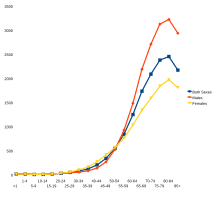**Group 1: Aging-Associated Diseases and Patterns of Differences**
– By age 3, about 30% of rats have had cancer, whereas by age 85 about 30% of humans have had cancer.
– Humans, dogs, and rabbits get Alzheimer’s disease, but rodents do not.
– Elderly rodents typically die of cancer or kidney disease, but not of cardiovascular disease.
– In humans, the relative incidence of cancer increases exponentially with age for most cancers.
– People with segmental progerias are vulnerable to different sets of diseases.
**Group 2: Research on Aging-Associated Diseases**
– Aging increases vulnerability to age-associated diseases, while genetics determines vulnerability or resistance.
– Some age-related changes are said to be unrelated to an increase in mortality.
– Strategies for engineered negligible senescence (SENS) aim to repair root causes for age-related illness.
– The SENS program has identified seven types of aging-related damage.
– Age-related diseases are proposed to be mediated by vicious cycles.
**Group 3: Specific Types of Aging-Associated Diseases**
– Macular degeneration affects the eyes and can lead to vision loss.
– Alzheimer’s disease is classified as a protein misfolding disease.
– Atherosclerosis is categorized as an aging disease.
– Benign prostatic hyperplasia is a noncancerous enlargement of the prostate gland.
– Cancer is most likely to affect patients over 65 years old.
**Group 4: Disease-Specific Details**
– Age-related macular degeneration (AMD) affects the central part of the retina.
– Alzheimer’s disease causes deposits of abnormal modified proteins in the brain.
– Atherosclerosis is brought about by vascular remodeling and plaque accumulation.
– Benign prostatic hyperplasia can block the bladder and interfere with urination.
– Most patients with invasive cancer are over 65 years old.
**Group 5: Other Aging-Associated Diseases and Statistics**
– Parkinson’s disease affects the central nervous system and mainly occurs in people over 60.
– Stroke was the second most frequent cause of death worldwide in 2011, with 95% of strokes occurring in people age 45 and older.
– Risk factors for stroke increase exponentially from 30 years of age, and two-thirds of strokes occur in those over the age of 65.
– Advanced age is a significant risk factor for stroke.
– Age-related diseases are common in elderly populations, with risk factors including genetics and lifestyle choices.
An aging-associated disease (commonly termed age-related disease, ARD) is a disease that is most often seen with increasing frequency with increasing senescence. They are essentially complications of senescence, distinguished from the aging process itself because all adult animals age (with rare exceptions) but not all adult animals experience all age-associated diseases. The term does not refer to age-specific diseases, such as the childhood diseases chicken pox and measles, only diseases of the elderly. They are also not accelerated aging diseases, all of which are genetic disorders.

Examples of aging-associated diseases are atherosclerosis and cardiovascular disease, cancer, arthritis, cataracts, osteoporosis, type 2 diabetes, hypertension and Alzheimer's disease. The incidence of all of these diseases increases exponentially with age.
Advanced glycation end-products contribute to nearly all aging-associated diseases.
Of the roughly 150,000 people who die each day across the globe, about two thirds—100,000 per day—die of age-related causes. In industrialized nations, the proportion is higher, reaching 90%.
